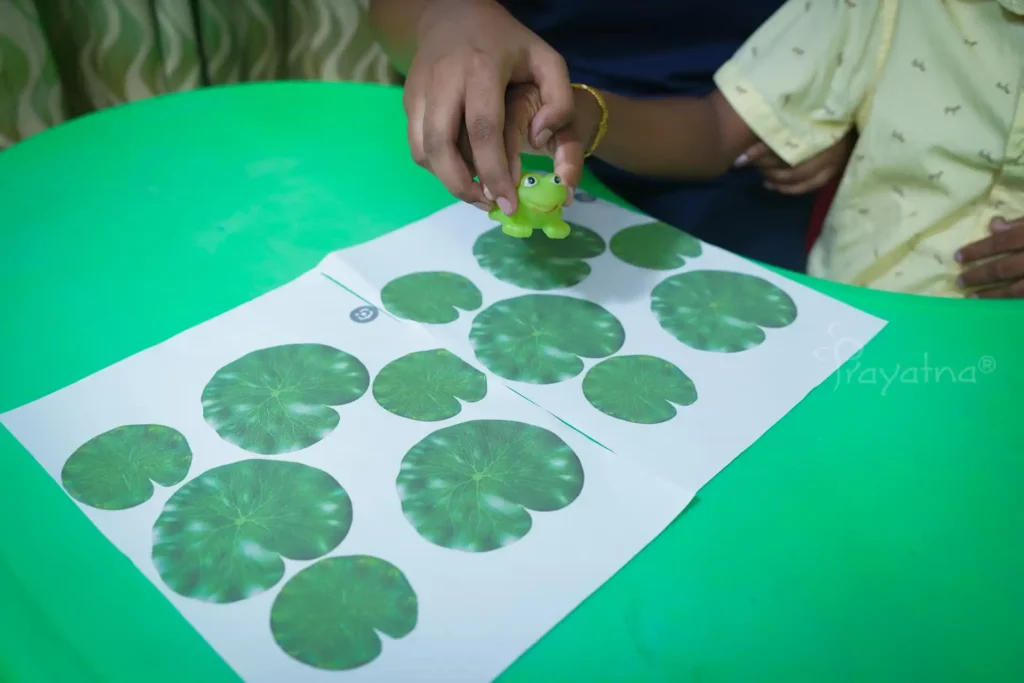
Written By
Sherine Shibu, BASLP, Speech Language Pathologist

Clinically Reviewd By
Joan Annie Jacob, BASLP, OPT(Level 2) Speech Language Pathologist
Understanding Autism Spectrum Disorder
What is autism spectrum disorder (ASD)?
Everyone around us is eager to know what Autism Spectrum Disorder looks like and how it is commonly seen in children. Autism Spectrum Disorder is a neurodevelopmental disorder that originates prior to birth or in early infancy.
As the name suggests, it is a spectrum of disorder that varies in terms of the severity of their symptoms. Since there are wide variations in different people with autism, the support required also varies widely; for example, some are non-speaking while others have good spoken language. One aspect consistent with children on the autism spectrum is that they are inconsistent.
Symptoms of Autism Spectrum Disorder
Prior to the age of three, ASD is characterized by two main symptoms: (1) persistent difficulties in social interaction and communication; and (2) limited or recurrent patterns of behaviour, interests, or activities that significantly affect everyday functioning.
Characteristics of autism spectrum disorder can be divided into three major groups of “core” deficits:
(1) chronic issues with social communication development
(2) linguistic and sensory issues
(3) limited or recurring attention, interest, and behaviour patterns (including fine and gross motor movement)
It is important to realize that not all children with ASD will demonstrate every characteristic and not to the same degree. Behaviour may vary on a daily basis.
Suggested Reading: High-functioning Autism: Diagnosis, and Treatment
How Autism Spectrum Disorder Affects Speech and Language Development
Many of the early signs of autism spectrum disorder or ASD are deficiencies in a child’s prelinguistic communicative behaviors that emerge prior to the speech. Prelinguistic skills include eye contact, name call response, attention, sitting tolerance, joint attention, etc.
Language disorders are a significant feature of ASD, and this includes deficits in understanding and expressing language at both the verbal and nonverbal levels. Moreover, language development is often an early indicator of ASD. Many children with ASD are nonverbal, but even those who are verbal often have difficulties in following rules for generating and understanding different words.
The verbal repertoires of other individuals with ASD may consist mainly of echoed speech(repeated speech), stilted speech(inappropriate speech), or strictly literal language.

Speech Therapy and Autism Spectrum Disorder
What is Speech Therapy?
Speech-language therapy is designed to address difficulties related to language and communication. It can help people with autism improve their verbal, nonverbal, and social communication skills. The overall goal of speech therapy is to help the person communicate in more functional and useful ways by incorporating his or her strength in it. Besides, a speech therapist can also help in improving speech and feeding since articulators(oral structures) used for speech production also help in the process of feeding. A speech therapist can help by suggesting methods to handle their feeding behaviours and feeding manners(positions, textures).
How Speech Therapy Can Help Children with Autism Spectrum Disorder
There is a wealth of information and facts related to autism. Following are some speech therapy approaches that would help to facilitate communication and language. Many children with autism spectrum disorders are much stronger visually than they are verbally.
Pictures as communication (AAC)
This approach focuses on teaching communication skills through the use of visual icons for those children who are visually strong and who are preverbal.
VIA (Visual interaction augmentation)
A strategy in which pictures of desired objects are exchanged by the child for the desired object itself. It addresses the lack of facial expressiveness, lack of gestural communication, & lack of verbal language. The best-known method is a model known as PECS (Picture exchange communication system).
Example: Do you want apples? Response: Exchanging of “NO” card or “YES” card functionally.
Social Pragmatic developmental approaches:
SPD approaches built on a child’s current communicative repertoire use more natural activities and events as contexts to support the development of children’s social communication abilities.
Example: Changing the position of the child’s favourite toy intentionally so that the child has to ask for it.
Techniques used in speech therapy for Autism Spectrum Disorder
Techniques used in reducing echolalia in ASD children
- Teaching verbal imitation skills:
Imitation is when a person copies or repeats gestures, actions, sounds, or words. Teaching appropriate speech to echolalic children can be viewed as the teaching of discrimination between appropriate and inappropriate speech imitation
(For example, if your child loves to play bubbles you can practices words like ‘‘bubble’’, ‘‘pop’’, ‘‘open’’, ‘‘blow’’, ‘‘wow’’)
- Prompting and prompt fading:
Prompting involves giving a level of assistance or help (can be visual, physical, verbal, etc.) to help the child complete a speech task. Prompt fading involves gradually reducing the level of assistance(can be visual, physical, verbal, etc.) given until a child is able to complete a speech task(naming, answering a question) independently.
Prompting
Example: What is this? By showing a model of an apple and then prompting is done by holding child’s hand and pointing to the model of an apple and tapping on it (physical and gestural prompt) to elicit the response ‘’apple’’
Prompting fading
Once you get the desired response from prompting, for example, the word ‘’apple’’ check at what level the child gave the response and slowly fade the level of prompt given to help the child make independent responses.
Benefits of Speech Therapy for Children with Autism Spectrum Disorder
Improved Communication Skills
children may show a regression in their speech and language skills which in-turn can affect their communication skills.
Speech therapy mainly focuses on the communication of the child in which it helps in
- The development of spoken language
- Improving understanding of intonation and inflection (humour and sarcasm) change
- Improving name-call response
- Incorporating echolalia (repeating or echoing words)for improving language and communication
- Improve topic initiation, maintenance and formation
Suggested Reading: Is Gadget Addiction in Children Causing Virtual Autism? Myth and Facts
Enhanced Social Interaction
The ways in which a child learns and understands how to socially engage in different places and with different people are guided by parents, friends and other interactions that the child receives, and it is something that tends to occur naturally. Children with Autism can have difficulty understanding and recognizing these unwritten social rules and social cues that are included in our daily interactions.
These social rules can be affected by many other factors such as age, gender and culture, and for kids with ASD, it is not applied uniformly.
Giving speech therapy will help
- Understand non-verbal cues and body language
- Improve conversational repair skills
- Improve joint attention
- Develop peer relationships appropriate to the developmental level
- Identify and make sense of social information (gestures, facial expressions, nuances of language etc.)
- Develop the ability to generate and formulate an appropriate response to match the varied and rapidly changing demands of different situations
Better Academic Performance
Neurodiverse children in a school setup generally face issues with their memory and auditory processing and also during transitions from one activity to another. Speech therapy identifies and addresses receptive areas of different concepts and improves understanding of reading and writing.
Reading comprehension and speech comprehension are the two main factors that help in developing academic skills. The patterns of training given in speech therapy can also help them in making transitions from one activity or topic to another. The emphasis is on positive strategies and verbally mediated teaching strategies.
Importance of Early Diagnosis and Intervention
The first five years of a child’s life are the most critical to the development of the child’s brain. During this time, different language inputs, stimulation and experiences that the child receives help him/her to improve their cognitive, emotional, and social well-being. Since the brain is ready to take up changes and learn new inputs, it is always easier to teach them a new skill or any kind of desired response at this age. Therefore early diagnosis followed by early intervention is always important, especially in the case of ASD kids.
An early, accurate diagnosis of ASD can
- Help families and caregivers access appropriate services,
- Provide a common language (verbal, sign, gestural) across interdisciplinary teams while communicating with the child
- Establish a structure to help families and caregivers understand the child’s challenges.
The Role of Speech Therapists in the Treatment of Autism Spectrum Disorder
A speech therapist may have the following common objectives: to improve spoken language, to develop nonverbal skills like signs or gestures, or to teach communication through alternative means (like pictures or technology).
Speech therapist can also help children improve and enhance skills that include:
- Improving the strength of oral muscles like mouth, jaw and neck
- Improving clarity of speech
- Help in feeding and swallowing
- Improving voice quality
- Understanding nonverbal language
- Responding to questions
- Improve social use of language
- Incorporating speech applications to help children communicate
- Improving voice tone modulations
Conclusion
As we discussed earlier, autism is not a disease but a spectrum of disorder with manifestation in areas of language, motor activity as well as sensory activity that differs from one to another. Speech therapy is an essential part of autism treatment. Speech and language development in autistic children may or may not result in a delay, and in the case of children with speech and language delay, speech therapy can help them to improve language, speech and communication. The aforementioned speech strategies and approaches can be used by parents at home under the guidance of a professional speech therapist to help their autistic children communicate. Together it is always a joy to teach our kids as well as to learn from them.

